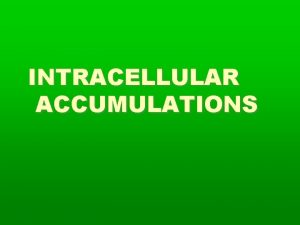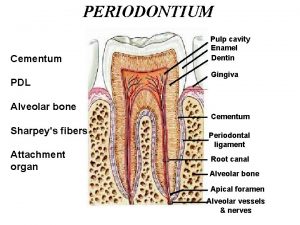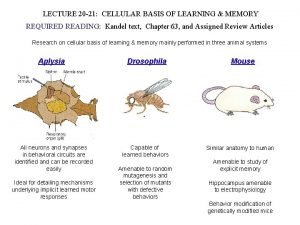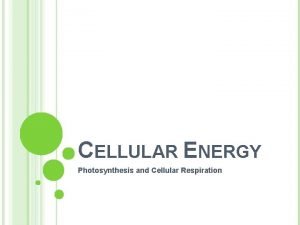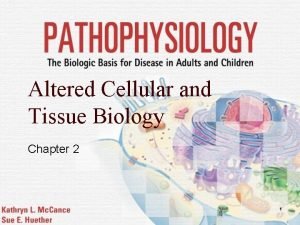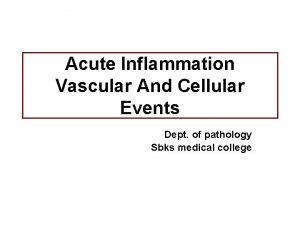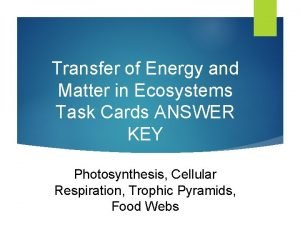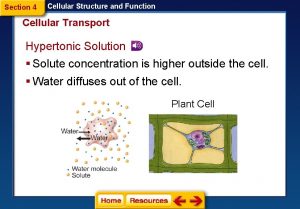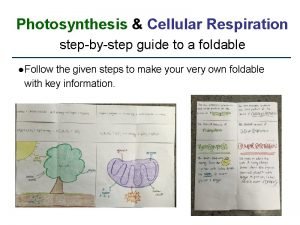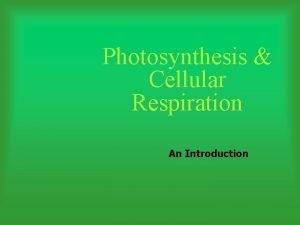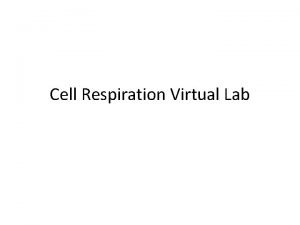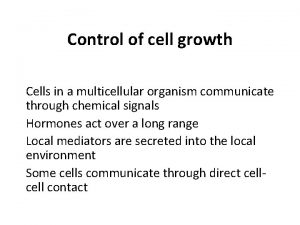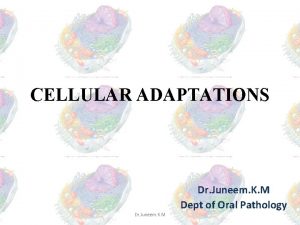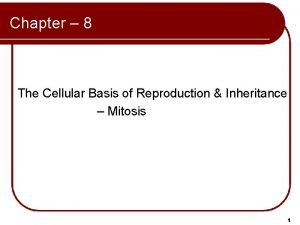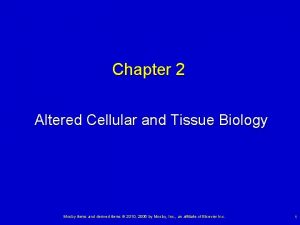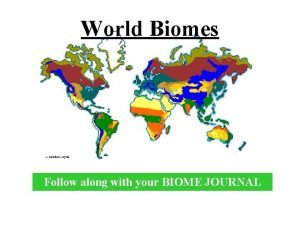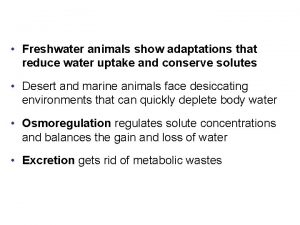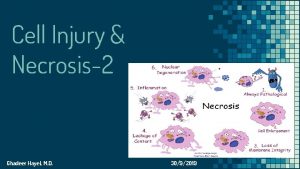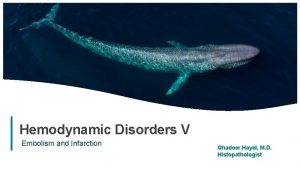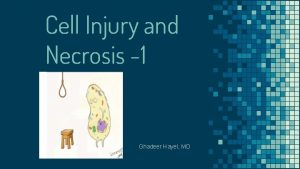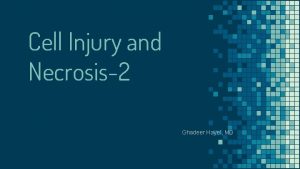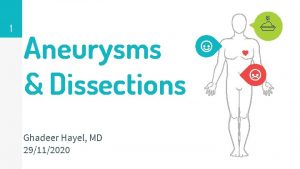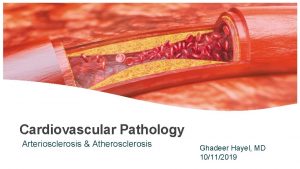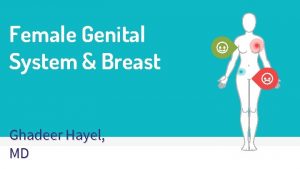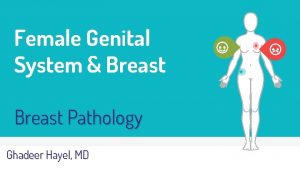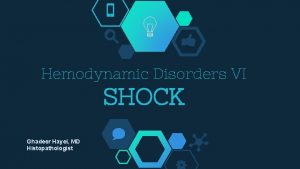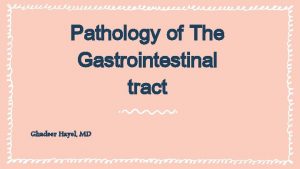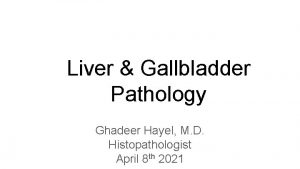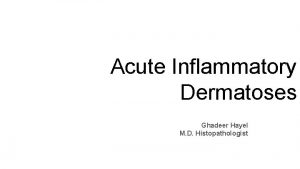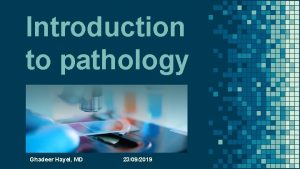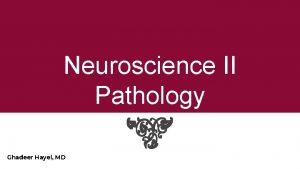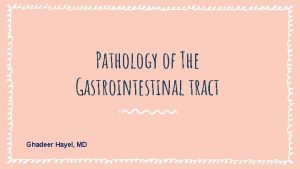Cellular Adaptations and accumulations Ghadeer Hayel MD 1































- Slides: 31

Cellular Adaptations and accumulations Ghadeer Hayel, MD 1

Adaptations • Reversible changes in the number, size, phenotype, metabolic activity, or functions of cells in response to changes in their environment. • Can be physiologic or pathologic. • Physiologic: responses of cells to normal (1) stimulation by hormones or endogenous chemical mediators. (Breast and uterus during pregnancy) or to the (2) demands of mechanical stress (bones and muscles) • Pathologic: responses to stress that allow cells to modulate their structure and function and thus escape injury, but at the expense of normal function. (squamous metaplasia of bronchial epithelium in smokers) 2

1. Hypertrophy • Hypertrophy is an increase in the size of cells resulting in an increase in the size of the organ. • Hypertrophy and hyperplasia also can occur together. • Hyperplasia is an increase in cell number. • Hyperplasia happens in cells capable of replication, whereas hypertrophy occurs when cells have a limited capacity to divide. • In pure hypertrophy there are no new cells, just bigger cells with increased amounts of structural proteins and organelles. • Hypertrophy can be physiologic or pathologic 3

Hypertrophy - physiologic - stimulation The massive enlargement of the uterus during pregnancy as a consequence of estrogen stimulated smooth muscle hypertrophy and smooth muscle hyperplasia. 4

Hypertrophy - physiologic - ↑ demand In response to increased workload the striated muscle cell undergo hypertrophy and because adult muscle cells have a limited capacity to divide, so the chiseled physique of weightlifter stems only from the hypertrophy 5

Hypertrophy - pathologic - ↑ demand In response to increased workload ( hypertension or aortic valve disease) myocardial hypertrophy (lower left to generate the required higher contractile force. The heart undergo only hypertrophy because cardiac muscles have a limited capacity to divide. 6

The mechanisms driving cardiac hypertrophy involve two types of signals • (1) mechanical triggers (stretch) & (2) soluble mediators that stimulate cell growth (growth factors and adrenergic hormones). • stimuli signal transduction pathways the induction of a number of genes stimulate synthesis of many cellular proteins (growth factors & structural proteins). • The result is synthesis of more proteins and myofilaments per cell, which increases the force generated with each contraction, enabling the cell to meet increased work demands. • Switch of contractile proteins from adult to fetal or neonatal forms. (α-myosin heavy chain is replaced by the fetal β-myosin heavy chain; which produces slower, more energetically economical contraction) 7

An important point • An adaptation to stress such as hypertrophy can progress to functionally significant cell injury if the stress is not relieved. • A limit is reached beyond which the enlargement of muscle mass can no longer compensate for the increased burden. • In the heart, several degenerative changes occur in the myocardial fibers, the most important are fragmentation and loss of myofibrillar contractile elements, ultimately cardiac failure. 8

2. Hyperplasia • Hyperplasia is an increase in the number of cells in an organ that stems from increased proliferation, either of differentiated cells or, in some instances, less differentiated progenitor cells. • Hyperplasia takes place if the tissue contains cell populations capable of replication. • may occur concurrently with hypertrophy • Hyperplasia can be physiologic or pathologic; in both situations, cellular proliferation is stimulated by growth factors that are produced by a variety of cell types. 9

The two types of physiologic hyperplasia are (1) Hormonal hyperplasia: the proliferation of the glandular epithelium of the female breast at puberty and during pregnancy. (2) Compensatory hyperplasia: residual tissue grows after removal or loss of part of an organ. (when part of a liver is resected mitotic activity in the remaining cells begins as early as 12 hours later, eventually restoring the liver to its normal size. • The stimuli here is polypeptide growth factors produced by uninjured hepatocytes and other nonparenchymal cells in the live. • After restoration of the liver mass, various growth inhibitors turn off cell proliferation. 10

Pathologic hyperplasia • Caused by excessive hormonal or growth factor stimulation. • E. g. Normally, Normally after a normal menstrual period there is a burst of uterine epithelial proliferation (tightly regulated by the stimulatory effects of pituitary hormones and ovarian estrogen and the inhibitory effects of progesterone) A disturbance in this balance increased estrogenic stimulation endometrial hyperplasia, (a common cause of abnormal menstrual bleeding). • Benign prostatic hyperplasia is (hormonal stimulation by androgens) • Certain viral infections (papillomaviruses cause skin warts and mucosal lesions - masses of hyperplastic epithelium), the growth factors may be encoded by viral genes or by the genes of the infected host cells 11

An important point The hyperplastic process remains controlled; if the signals that initiate it abate, the hyperplasia disappears. It is this responsiveness to normal regulatory control mechanisms that distinguishes pathologic hyperplasias from cancer, in which the growth control mechanisms become permanently dysregulated or ineffective. In many cases, pathologic hyperplasia constitutes a fertile soil in which cancers may eventually arise. 12

3. Atrophy • Atrophy is shrinkage in the size of cells by the loss of cell substance. • If a sufficient number of cells are involved, the entire tissue or organ is reduced in size (atrophic). • Atrophic cells may have diminished function, they are not dead. • Causes of atrophy include a decreased workload (immobilization of a limb to permit healing of a fracture), loss of innervation, diminished blood supply, inadequate nutrition, loss of endocrine stimulation, and aging (senile atrophy). • Some of these stimuli are physiologic (the loss of hormone stimulation in menopause) and others are pathologic (denervation), but the fundamental cellular changes are similar. • A retreat by the cell to a smaller size at which survival is still possible. 13

• The process of cellular atrophy results from a combination of: (1) decreased protein synthesis: reduced metabolic activity. (2) increased protein degradation: occurs mainly by the ubiquitin-proteasome pathway: • Nutrient deficiency and disuse may activate ubiquitin ligases, which attach multiple copies of the small peptide ubiquitin to cellular proteins and target them for degradation in proteasomes. • This pathway is also responsible for the accelerated proteolysis seen in a variety of catabolic conditions, including the cachexia associated with cancer. • In many situations, atrophy also is associated with autophagy. 14

Atrophy - pathologic - ↓ blood supply 82 -year-old man with atherosclerotic disease. Atrophy of the brain is caused by aging and reduced blood supply. Note that loss of brain substance narrows the gyri and widens the sulci. The meninges have been stripped from the bottom half of each specimen to show the surface of the brain. 15

4. Metaplasia • In Metaplasia; one adult cell type (epithelial or mesenchymal) is replaced by another adult cell type. • Here a cell type is sensitive to a particular stress is replaced by another cell type better able to withstand the adverse environment. • It arise by the reprogramming of stem cells to differentiate along a new pathway and not by a phenotypic change (transdifferentiation) of already differentiated cells. 16

• In the respiratory epithelium of habitual cigarette smokers the normal ciliated columnar epithelial cells of the trachea and bronchi metaplasia stratified squamous epithelial cells. • The rugged stratified squamous epithelium can survive the noxious chemicals in cigarette smoke that columnar epithelium would not tolerate. • Metaplasia here has survival advantages, but important protective mechanisms are lost, such as mucus secretion and ciliary clearance. 17

• In chronic gastric reflux; the normal stratified squamous epithelium of the lower esophagus metaplasia gastric or intestinal-type columnar epithelium. • Metaplasia also occur in mesenchymal cells, where it is generally a reaction to some pathologic alteration (bone is occasionally formed in soft tissues, particularly in foci of injury. 18

• The influences that induce metaplastic change in an epithelium, if persistent, may predispose to malignant transformation. • Squamous cell metaplasia of the respiratory epithelium often coexists with lung cancers composed of malignant squamous cells. • And columnar epithelium in the esophagus can coexist also with esophageal cancer of adenocarcinoma type. 19

Intracellular Accumulations 20

Intracellular accumulations • Cells may accumulate abnormal amounts of various substances under some circumstances, can be harmless or cause varying degrees of injury. • The substance may be located in the cytoplasm, within organelles (lysosomes), or in the nucleus. • Synthesized by the affected cells or it may be produced elsewhere. • The main pathways of abnormal intracellular accumulations are (1) inadequate removal and degradation. (2) excessive production of an endogenous substance. (3) deposition of an abnormal exogenous material. 21

Fatty Change q Fatty change, called steatosis. q Any accumulation of triglycerides within parenchymal cells. q Mostly seen in the liver, (the major organ involved in fat metabolism) , also occur in heart, skeletal muscle, kidney, and other organs. q Caused by toxins, protein malnutrition, diabetes mellitus, obesity, or anoxia. q Alcohol abuse and diabetes associated with obesity are the most common causes of fatty change in the liver. 22

Cholesterol and Cholesteryl Esters q Cellular cholesterol metabolism is tightly regulated to ensure normal generation of cell membranes (in which cholesterol is a key component) without accumulation. q Phagocytic cells may become overloaded in different pathologic processes, mostly increased intake or decreased catabolism of lipids. q Atherosclerosis is the most important. 23

Proteins. q Morphologically visible protein accumulations are less common than lipid accumulations. q Normal Kidney: trace amounts of albumin filtered through the glomerulus are normally reabsorbed by pinocytosis in the proximal convoluted tubules. q In disorders with heavy protein leakage (nephrotic syndrome), much more of the protein is reabsorbed, and vesicles containing this protein accumulate, giving the histologic appearance of pink, hyaline cytoplasmic droplets. q The process is reversible: if the proteinuria abates, the protein droplets are metabolized and disappear. 24

Glycogen. q Excessive intracellular accumulation of glycogen are associated with abnormalities in the metabolism of glucose or glycogen. q In poorly controlled diabetes mellitus, the prime example of abnormal glucose metabolism, glycogen accumulates in renal tubular epithelium, cardiac myocytes, and β cells of the islets of Langerhans. q Glycogen also accumulates within cells in a group of related genetic disorders collectively referred to as glycogen storage diseases. 25

Pigments – Carbon • Pigments are colored substances : • + exogenous (from outside the body) such as carbon, • + endogenous (synthesized within the body) itself, such as lipofuscin, melanin, and certain derivatives of hemoglobin. • The most common exogenous pigment is carbon, a ubiquitous air pollutant of urban life. • When inhaled phagocytosed by alveolar macrophages transported by lymphatic channels to regional lymph nodes. • Aggregates of the pigment blacken the draining lymph nodes and pulmonary parenchyma (called anthracosis) 26

Pigments-Lipofuscin “wear-and-tear pigment’’ • An insoluble brownish-yellow granular intracellular material that accumulates in a variety of tissues (heart, liver, and brain) with aging or atrophy. • Lipofuscin represents complexes of lipid and protein that are produced by the free radical– catalyzed peroxidation of polyunsaturated lipids of subcellular membranes. • It is not injurious to the cell but is a marker of past free radical injury. • When present in large amounts, imparts an appearance to the tissue that is called brown atrophy. 27

Pigments - Melanin. • An endogenous, brown-black pigment that is synthesized by melanocytes located in the epidermis. • Acts as a screen against harmful UV radiation. • Although melanocytes are the only source of melanin, adjacent basal keratinocytes in the skin can accumulate the pigment (e. g. , in freckles), as can dermal macrophages. 28

Pigments - Hemosiderin. • A hemoglobin-derived granular pigment that is golden yellow to brown. • Accumulates in tissues when there is a local or systemic excess of iron. • Iron is normally stored within cells in association with the protein apoferritin, forming ferritin micelles. • Hemosiderin pigment represents large aggregates of these ferritin micelles, readily visualized by light and electron microscopy. 29

… Pigments - Hemosiderin. • the iron can be unambiguously identified by the Prussian blue histochemical reaction • Small amounts of this pigment are normal in the mononuclear phagocytes of the bone marrow, spleen, and liver, where aging red cells are normally degraded. • Excessive deposition of hemosiderin, called hemosiderosis. • more extensive accumulations of iron seen in hereditary hemochromatosis 30

THANK YOU & GOOD LUCK Insert Image 31
 Intracellular accumulations
Intracellular accumulations Ghadeer khum
Ghadeer khum Complementary processes
Complementary processes Photosyntehsis equation
Photosyntehsis equation Cementum
Cementum Ltp
Ltp Equation for cell respiration
Equation for cell respiration Formula for photosynthesis and cellular respiration
Formula for photosynthesis and cellular respiration Altered cellular and tissue biology
Altered cellular and tissue biology Vascular and cellular events of acute inflammation
Vascular and cellular events of acute inflammation Cellular and molecular immunology
Cellular and molecular immunology Photosynthesis and cellular respiration diagram
Photosynthesis and cellular respiration diagram Chapter 7 section 4 cellular transport
Chapter 7 section 4 cellular transport Cellular respiration foldable
Cellular respiration foldable Cellular transport and the cell cycle
Cellular transport and the cell cycle Cellular respiration edpuzzle
Cellular respiration edpuzzle Unicellular/multicellular
Unicellular/multicellular Photosynthesis and cellular respiration
Photosynthesis and cellular respiration Rank order clustering algorithm
Rank order clustering algorithm Cellular respiration virtual lab snails and elodea
Cellular respiration virtual lab snails and elodea Plants called sundews have rounded green leaves
Plants called sundews have rounded green leaves Cellular adaptation of growth and differentiation
Cellular adaptation of growth and differentiation Cellular adaptation of growth and differentiation
Cellular adaptation of growth and differentiation Photosynthesis and cellular respiration jeopardy
Photosynthesis and cellular respiration jeopardy Forensics pathology definition
Forensics pathology definition The cellular basis of reproduction and inheritance
The cellular basis of reproduction and inheritance Altered cellular and tissue biology
Altered cellular and tissue biology Savanna animals adaptations
Savanna animals adaptations Chapter 25 plant responses and adaptations answer key
Chapter 25 plant responses and adaptations answer key Behavioral adaptations examples
Behavioral adaptations examples Freshwater animals adaptations
Freshwater animals adaptations Muslim innovations and adaptations answers
Muslim innovations and adaptations answers
